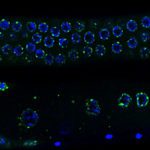Link to Pubmed [PMID] – 24681887
Nat. Struct. Mol. Biol. 2014 Apr;21(4):358-65
Argonaute proteins and their small RNA cofactors short interfering RNAs are known to inhibit gene expression at the transcriptional and post-transcriptional levels. In Caenorhabditis elegans, the Argonaute CSR-1 binds thousands of endogenous siRNAs (endo-siRNAs) that are antisense to germline transcripts. However, its role in gene expression regulation remains controversial. Here we used genome-wide profiling of nascent RNA transcripts and found that the CSR-1 RNA interference pathway promoted sense-oriented RNA polymerase II transcription. Moreover, a loss of CSR-1 function resulted in global increase in antisense transcription and ectopic transcription of silent chromatin domains, which led to reduced chromatin incorporation of centromere-specific histone H3. On the basis of these findings, we propose that the CSR-1 pathway helps maintain the directionality of active transcription, thereby propagating the distinction between transcriptionally active and silent genomic regions.

